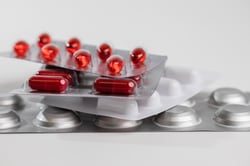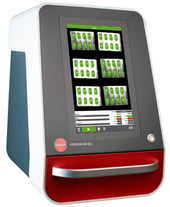Blue dye water bath or dye ingress testing remains the most common method for pharmaceutical manufacturers to leak test blister packs, despite its drawbacks. With more and more companies looking to improve their environmental footprint, is it time to ditch blue dye and switch to non-destructive leak test methods?
In this blog post we discuss the drawbacks of destructive leak test methods and highlight how alternative, non-destructive methods are a much greener choice.
Product waste
The main drawback of using dye ingress methods is the unnecessary waste it creates in terms of ‘good packs’. The process itself requires blister packs to be put in a water bath to be tested. All packs, whether they pass or fail the test, will need to be disposed of.
Non-destructive methods do not affect the packs during the test, enabling manufacturers to put packs that pass the test back on the line, or recover the product from the packaging to be repacked. Depending on how valuable the drug inside the packs is, and how many packs are tested each hour, cost savings can be huge.
Incineration cost
In addition to the cost incurred in terms of product waste, destructive methods also have considerable incineration cost. Every pack that’s tested will have to be disposed of, even the good ones. Incineration processes could in turn lead to high energy consumption, CO2 emissions or other environmental pollutants.
As non-destructive methods are a ‘dry’ process, tablets and capsules can be recovered from faulty packs and repackaged, reducing the need for incineration and related cost.
Untreated water waste
 Besides the fact that water bath testing requires a daily amount of clear water to run the test, there is a risk of the water being contaminated. Leaks can expose the drug that's inside the packaging and contaminate the water. As this untreated wastewater can be harmful to the environment, it can’t just go down the drain and needs to be disposed of properly. Associated water treatment or disposal cost will eat into profits, which can be avoided when using non-destructive methods.
Besides the fact that water bath testing requires a daily amount of clear water to run the test, there is a risk of the water being contaminated. Leaks can expose the drug that's inside the packaging and contaminate the water. As this untreated wastewater can be harmful to the environment, it can’t just go down the drain and needs to be disposed of properly. Associated water treatment or disposal cost will eat into profits, which can be avoided when using non-destructive methods.
Subjective test results
Blue dye testing is not only a destructive method, it’s also subjective, as it relies heavily on operator judgement. Advanced test methods offer non-destructive solutions that are deterministic in line with USP 1207 guidelines. Multiple blister packs can be tested simultaneously and a simple ‘pass/fail’ can be given for individual blister pockets. New technologies also offer more accuracy as they can identify micron holes as low as 5µm. Blue dye testing can be limited in identifying smaller defects, passing packages that fail using non-destructive tests.
Making the switch
Considering the outlined drawbacks including cost, environmental impact and the subjective nature of dye ingress testing, is now the time to make the switch?
Change can be a difficult topic to address, especially in pharmaceutical settings. Despite the many benefits non-destructive & deterministic test methods provide compared to blue dye testing, change might be challenged by different departments. But it doesn’t need to be.
Making the switch will require some work in updating Standard Operating Procedures (SOPs), validation protocols and other documentation. However, the cost savings, operation improvements and carbon footprint reductions will drive efficiencies for your business, making the switch worth it in the long run.
Introducing the Sepha VisionScan 3D
 Sepha’s 3D Leak Detection technology uses a non-destructive and deterministic leak test method to identify defects in blister packs down to 5 micron. The VisionScan 3D offers a flexible, reliable, deterministic and cost saving alternative to destructive leak testing. It utilizes the principle of vacuum deflection according to ASTM standard test method F3169-16 (2024). The method does not affect the integrity of the blister pack, allowing packs that have passed the test to be returned onto the production line. The machine is easy to operate and requires minimum operator training. More information can be found on the VisionScan 3D product page or via the on-demand webinar ‘3D Leak Detection of Blister Packs’
Sepha’s 3D Leak Detection technology uses a non-destructive and deterministic leak test method to identify defects in blister packs down to 5 micron. The VisionScan 3D offers a flexible, reliable, deterministic and cost saving alternative to destructive leak testing. It utilizes the principle of vacuum deflection according to ASTM standard test method F3169-16 (2024). The method does not affect the integrity of the blister pack, allowing packs that have passed the test to be returned onto the production line. The machine is easy to operate and requires minimum operator training. More information can be found on the VisionScan 3D product page or via the on-demand webinar ‘3D Leak Detection of Blister Packs’
Sepha Solutions
Founded in 1980, Sepha has established a global reputation for innovation and development of specialised, high-quality equipment for use in the manufacture of pharmaceutical blister packs, parenterals, medical devices and healthcare products.
Interesting articles


